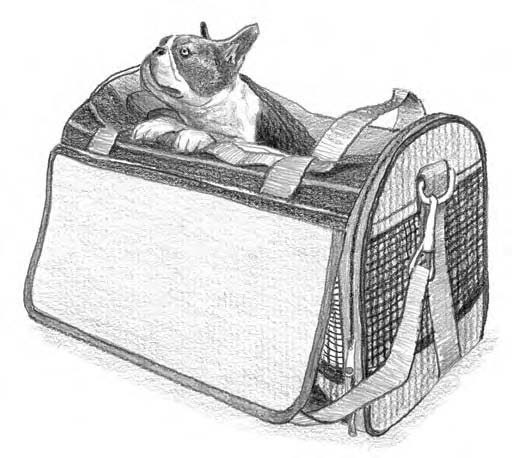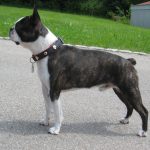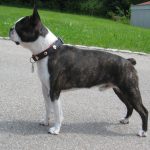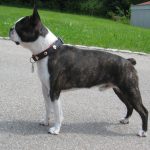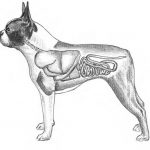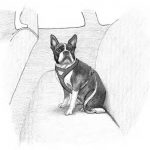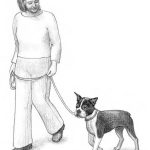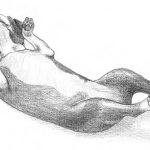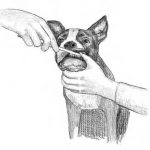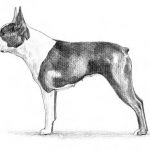In This Chapter
- Preparing your home and yard for your new arrival
- Licensing and registering your Boston
- Creating a shopping list of basic Boston necessities
Your Boston is coming home and will want to explore his new surroundings. His arrival, however, requires some careful planning to ensure his safety, health, and happiness. From putting away puppy temptations to buying the most nutritious food, your dog relies on you for his well-being and survival.
This chapter explains how to puppy-proof or dog-proof your home and yard, describes how to properly license and register your dog, and gives you a shopping list of essential equipment you need in anticipation of his homecoming.
Puppy-Proofing Basics
Preparing your home and yard for a new puppy is similar to doing so for a curious toddler. Look at the world from your Boston Terrier’s perspective — about 2 feet off the ground! Your pup will want to investigate every electrical cord, every closet, and every rut in the yard, and he won’t distinguish between your favorite pair of shoes and his chew toy.
The following sections point out common puppy temptations that you’ll find both inside and outside. By removing the temptations before he comes home, you’ll set up your Boston to succeed.
Remember
These suggestions are intended to be an overview of what your Boston may come across in his new home. Thoroughly inspect your home and yard before your pup comes home, and continue to do so daily. If your dog swallows something that may be harmful or injures himself in any way, contact your veterinarian immediately.
Stashing stuff inside your home
From the kitchen to the office, temptations abound inside the home. Small items that resemble playthings are easy prey for your pup. Look at the surroundings from your dog’s point of view — best done by getting down on all fours — and pay particular attention to the following areas.
Kitchen
The kitchen contains all sorts of interesting drawers, cabinets, and cords, not to mention smells and tastes. If he can get into a cabinet or drawer, your Boston will explore everything inside. Childproof latches, which can be found at your local hardware store, prevent curious pups from investigating off-limit areas and keep potentially dangerous foods and cleaning supplies out of reach.
Power cords look like fun chew toys to a teething Boston. Tucking them out of reach, blocking them, or enclosing them in a chewproof PVC tube will divert your dog’s attention.
Tempting smells entice Bostons, too. Be diligent about putting leftovers away rather than leaving them on the counter. And secure the garbage can with a locking lid or store it behind a latched cabinet door to keep the rubbish inside the can — not all over the kitchen floor (or inside your Boston’s belly)!
Bathroom
The bathroom can be a dangerous place for a Boston. Razors, pills, cotton swabs, and soap left within your dog’s reach can be easily chewed and ingested — which can mean an emergency visit to your veterinarian. Family members need to be conscientious about cleaning up after themselves in the bathroom. Put shampoos, soap, tissues, and accessories out of reach or inside a cabinet or drawer.
Especially while your Boston is young, keep the toilet lid down at all times, or keep the bathroom door closed. A curious pup can jump into the bowl and drown.
As with the kitchen, use a trash can with a locking lid, or stash it under the sink. Also install childproof latches on the drawers and cabinets, and be sure to tuck dangling cords away.
Bedroom
Dogs are scent oriented, so they gravitate toward anything that smells like you. Shoes, slippers, and clothing will quickly become toys if you don’t safeguard such items behind a closed closet door. Keep clothing picked up, store shoes out of reach, and put laundry in a tall, closed hamper.
Store jewelry, hair ties, coins, and other small ingestible items in containers or drawers, and secure any exposed cords or wires. Many dogs like to den under the bed or wedge themselves behind furniture, so put up temporary blockades to prevent your Boston from hiding where he shouldn’t.
Office
Your Boston may be drawn by all sorts of temptations in your office: papers, magazines, cords, wires, paperclips, rubber bands, and staples. These items may be fun to play with, but they can be fatal if chewed or swallowed. As with the rest of the house, pick up strewn office supplies, secure or enclose cords and wires, and keep decorative items well out of your Boston’s reach.
Plants attract dogs, too, so place them on a shelf or counter if possible. If not, consider putting them in a spare room and keeping the door closed until your Boston has graduated from his curious puppy stage.
Minimizing outdoor hazards
When you look around your garage and yard, you’ll see many obvious and not-so-obvious dangers to your Boston. Just as you inspected and puppy-proofed the inside of your home from your dog’s perspective, do the same with the outside of your home.
Poisons and chemicals
Paint, cleaners, insecticides, fertilizers, antifreeze, and gasoline represent a handful of poisons and chemicals that you may have in your garage or outdoor shed. Antifreeze, for example, has a sweet taste that attracts animals, but it can be deadly if ingested, even in small amounts. Secure all bottles, boxes, and containers of these substances behind a locked cabinet door, or store them on high shelves that your pup can’t reach.
Rat poisons, snail bait, and ant traps can look like toys or tasty treats to your pet, but they, too, should be put away when your Boston comes home.
Plants
Bostons are curious dogs, and they’ll investigate — and possibly dig up — many of the plants in your yard if left unattended. Some plants, such as daffodils, foxglove, Bird of Paradise, and lupine, can be poisonous to your dog and cause varied reactions, ranging from a rash to vomiting and diarrhea. You can find a list of the most commonly encountered toxic plants at the American Society for the Prevention of Cruelty to Animal’s Animal Poison Control Center Web site:
www.apcc.aspca.org.
Protect your pup — and your foliage — by fencing in plants and delineating where he is allowed and where he isn’t.
Tools and gardening equipment
Though they may be too unwieldy for a Boston pup to wrangle, power tools, cords, and gardening equipment should also be kept out of his reach. Sniffing a sharp blade could cut his delicate nose,or tugging on a cord may cause a heavy saw to fall and break one of his bones, or worse.
License and Registration, Please
In most counties and states, licensing your Boston Terrier is the law. You will need to apply for and obtain a dog license from your local animal control agency soon after you bring your pup home.
Registering him with one of the national or international dog registries is voluntary. This process begins with the breeder, who first registers her dog’s litter. When you take ownership of the puppy, the breeder gives you a dog registration application, which you must complete and mail to the registering organization. You can do this before or after you bring your Boston home, but it must be done before the pup reaches his first birthday.
Making your Boston legal
Depending on where you live, county or state laws require that your dog be licensed. A dog license gives you permission to legally own the animal. The dog-licensing agency issues an identification number along with a dog tag bearing the number that your Boston wears at all times.
The licensing laws are in place to protect your dog and other animals against rabies, which can threaten their lives. Licensing your Boston also ensures that he will be returned to you if he wanders away from home and is picked up by animal control. The fees you pay for licenses go toward returning thousands of animals to their homes each year, finding homes for thousands more, and contributing to spay/neuter programs in your area.
Tip
To apply for a dog license, contact your local animal control agency. They will send you a form that will ask for your name, address, and phone number, as well as your pet’s name, breed, sex, age, microchip number (if applicable), and whether your Boston has been spayed or neutered. The agency may also require a copy of your pup’s rabies vaccination and sterilization certificates.
Upon approval of your documentation, you will receive a licensing tag with a unique number that you need to attach to your dog’s collar and make sure he wears it at all times. If your Boston makes a run for it, chances are good that he will be picked up and returned to you if he is wearing his collar and tag.
Licensing fees vary from area to area, but generally, unaltered animals cost more to license than spayed or neutered animals. Renewal forms are sent annually.
Registering with the AKC and UKC
The American Kennel Club (AKC) and the United Kennel Club (UKC), the two most well-known dog registries in the United States, record purebred dogs and issue them an AKC or UKC registration number.
Dog registries have specific requirements for eligibility. For example, to be eligible for registration, your Boston’s parents, the sire (the papa dog) and the dam (the mama dog), and their litter must also have been registered by their owners and the breeder. You can check with the individual registries for additional requirements.
Benefits of registering your Boston include
– Permanently recording him in the AKC or UKC registry
– Obtaining a certificate of registry
– Gaining access to various ancillary benefits. For example, the AKC offers a free pet healthcare trial, a certificate for a free veterinary visit, a new puppy handbook, and eligibility to participate in competitive AKC-sanctioned events.
To register your Boston, you need to fill out the application jointly with the litter’s owner. She provides the dog’s sex, color and markings, whether the registration is standard or limited (meaning a single dog whose litter won’t be eligible for registration), transfer date, your name and address, and her signature.
You provide the dog’s name, payment information, registration options, and your signature. Both registries charge a nominal, nonrefundable fee. When the application and fees are approved, you receive an official certificate of registry.
To delve further into choosing and buying a Boston from a registered breeder, turn to Chapter
A Match Made in Boston.
Time to Go Shopping
Shopping for your Boston, which is like shopping for a furry member of the family, can be intimidating! Walk through any pet boutique, big-box retailer, or local department store, like Target or Wal-Mart, and you’ll see aisles of premium diets and treats, plush beds, toys of every shape and size, and even haute doggy couture.
It’s temping to splurge on your new dog. Don’t worry: You’ll have plenty of time to do that. To begin with, however, you can pick up a few items to make your Boston Terrier’s homecoming smooth. Brands, quality, and costs run the gamut. Shop around, but don’t sacrifice quality for price.
So many leashes and collars, so little time
Your Boston will need a collar, leash, and possibly a harness soon after you bring him home. This section gives you the scoop. Also check out Figure 5-1 for an assortment of popular choices.
Collars
A collar makes more than a fashion statement; it also holds the dog’s licensing tag and ID tag, which lists your contact information should he ever get lost. The collar also attaches to the leash, which you need to walk your Boston.
Tip
For your dog’s first few collars, pick up an adjustable nylon type with a buckle. These collars come in a variety of colors and styles to fit your Boston’s personality. To find the right size, either measure the diameter of your Boston’s neck and add 2 inches for some growing room, or take your dog to the pet store and try some on him. Plan to buy several collars as your pup grows.
After your Boston is fully grown, decorative collar choices are endless. You can buy a diamond-encrusted leather collar, a colorful vinyl collar, or even a studded motorcycle-dog collar! You can even buy collars to match outfits or to celebrate seasons.
Figure 5-1: Collars, leashes, and harnesses come in many varieties.
Remember
Whatever collar you choose, be sure that it’s sized and weighted appropriately for your Boston. Big heavy collars can catch on objects and choke your dog; small cat collars can be too restrictive.
Other collars designed for training purposes, such as slip chain or choke collars, can be purchased after your Boston’s a little older and you’ve consulted with your veterinarian or a professional trainer on how to use them correctly.
Leashes
The leash, which attaches to the collar, gives you control during walks or obedience training. You can coordinate the leash and collar so they match. When you purchase a leash, make sure the attachment won’t break or unhook from the collar, and choose one with a strong and comfortable loop for your hand.
Like collars, leash choices include an array of lengths, styles, and materials, including nylon, hemp, cotton, leather, and vinyl. For your Boston’s first few leashes, a 4-foot nylon, cotton webbing, or leather variety is all you need. As you begin obedience training, you’ll need longer leashes, including 6-foot and 15-foot lengths.
Harnesses
You can also choose a harness for your Boston. Rather than loop around your dog’s neck, a harness loops around his shoulders and torso (see Figure 5-1 for an example). The dog steps into it, and you simply snap or buckle it closed. The leash attaches to the back of the harness instead of the collar, putting the pressure around his body instead of his neck.
You can use a harness and collar interchangeably, but a harness is especially suitable for Bostons who pull when walking. A harness doesn’t give you as much control as a collar, but it does prevent the dog from gasping or choking if he leads you on excursions.
Unmistaken identity
Your Boston will require some identification, and you can choose from several options: ID tags, tattoos, and microchips. They each have their benefits and drawbacks, so the best option is to use a combination of at least two.
– ID tags: Readily visible on your dog’s collar, ID tags list information about your dog and you, such as your Boston’s name and your name, address, and telephone number. At the very least, list your name and the best way to contact you, whether it be a cellphone, office phone, or home phone. (If you’re wondering how an ID tag is different from a license tag, the answer is simple: The license tag usually lists the dog’s license number and the animal control agency’s phone number. It generally doesn’t list all of the personal information included on an ID tag.)
ID tag styles include plastic, engraved metal, and reflective tags in all shapes, sizes, and colors. You can order them from your veterinarian or purchase them at your local pet store. These tags are the most common form of identification, and they are often used to reunite a lost dog and owner. If you have several collars for your Boston, be sure each one has an ID tag.
Remember
ID tags can fall off the collar, and sometimes the engraving wears off, the imprint fades, or the tag becomes too worn to read. So regularly check the ID tag to make sure it’s still attached to the collar and is readable. And if you move to a new home, make sure the tag has your current information on it.
– Tattoos: Tattoos are another identification option (and I’m not talking about an image of a fire hydrant permanently painted on his foreleg). An authorized tattooer, generally recommended by your veterinarian or breeder, tattoos a unique number on your Boston’s skin, typically on his belly or inner thigh. A virtually painless procedure, the tattoo is done with no anesthetic and takes only minutes to do. First, the dog is placed on his side, and you hold his head and front paws while an assistant holds his back paws. Then, the area is shaved and disinfected. The tattoo is applied, the area is washed thoroughly, and a light coating of petroleum jelly is applied over the top. The area heals completely in several days, leaving behind a permanent identification number.
The number can be virtually any sequence you choose: the dog’s AKC or UKC number, a random number selected by the tattoo registry, or even your Social Security number, which, historically, has been the number of choice. The number is then listed with one of several national tattoo databases. When your dog is found, the shelter contacts the various registries and matches the tattoo number to you.
Warning!
This ID method is a less reliable way to guarantee that your dog will be returned to you. The person who finds your dog may not know to look for a tattoo, and if she does, she may not know what it signifies or how to access the national database. If you decide to tattoo your Boston, use a secondary form of identification, like an ID tag, that lists your contact information.
– Microchips: A rice-sized microchip is another method of identifying your Boston. Injected by your veterinarian between your dog’s shoulder blades, this microchip contains a code that is stored in a database with your contact information. When your dog is found, a staff member at the shelter uses a handheld scanner to read the code in the microchip. The code is then entered into the database, which tells the shelter your name and phone number, so you and your dog can be reunited.
Remember
If you have your dog microchipped, take the time to register your contact information and keep it up to date. The microchip won’t do any good if there’s no name or phone number associated with it, or if the information is incorrect! Similarly, if you move, change your phone number, or sell your dog, notify the registry and update it as necessary.
Fine china or basic bowls
Your Boston will need food and water bowls when he comes home. These doggy dishes vary as much as dinnerware patterns for people. From custom-painted ceramic ware and hand-thrown pottery to sleek stainless steel bowls and durable plastic dishes, place settings for your pooch have as much personality as the Bostons themselves. Elevated racks adorned with wrought iron or carved wood add elegance to the food and water bowls (see Figure 5-2).
Figure 5-2: You can go as low- or high-end with food bowls as you like.
Each material has its benefits and drawbacks:
– Plastic bowls are lightweight and inexpensive, but they retain residue and harbor bacteria as they break down. Your Boston may chew on his bowl and swallow the little plastic pieces. Then you may be making an unplanned trip to the vet. If you choose plastic, purchase a harder, dishwasher-safe plastic and replace it at the first signs of wear.
– Custom ceramic pieces weigh more than plastic dishes, so they’re not likely to tip over or be turned into a toy. However, these dishes are more expensive and breakable, and if they’re made overseas, they may contain lead, which can be harmful to your Boston. Make sure any piece you choose is sturdy, lead-free, and dishwasher safe. You can find beautiful bowls in designs to match virtually any décor.
– Stainless steel bowls, though generally the most expensive, clean and sanitize easily. They’re heavy enough that your dog won’t wander off with one, and they’re virtually indestructible. Some designs include rubber bases to keep them from sliding across the floor as your Boston scarfs down dinner.
Your Boston will need at least two sets of bowls (two for food and two for water) that you can rotate so you can wash them regularly. Because your Boston will grow to only 25 pounds, a 16- or 24-ounce, standard-depth bowl will suffice.
Items to keep your Boston contained
A must for any puppy owner, containment devices keep your Boston in a confined area where you can monitor and housetrain him. You will need a dog crate or carrier, and an X-pen, playpen, or gate when you bring your Boston home.
Carriers come in three categories:
– The crate or travel carrier, which doubles as a den and can be used in the home, the car, or on an airplane
– The around-town tote, which transports a pup into dogfriendly establishments
– The pet purse, which looks like a handbag and takes the pet into taboo places, like restaurants and theaters
X-pens, playpens, and baby gates corral curious puppies. If you are unable to keep your eyes on your Boston, pens and gates offer an excellent short-term solution.
You can find a full range of carriers at your local pet store or pet specialty boutique; look for the X-pens, playpens, and baby gates in the baby section of most major department stores.
Quality matters when selecting crates, carriers, and containment devices. Choose the highest quality that you can afford to keep your Boston safe while he’s contained.
Crates and travel carriers
Crates and travel carriers not only provide for your Boston’s easy transport to and from the veterinarian’s office, but they also serve as a housetraining tool, a cozy dog den, and a place for him to hide when strangers come to visit.
Crates and kennels come in a wide variety of sizes and materials, including plastic, nylon, powder-coated wire, and stainless steel (see Figure 5-3). The hard-sided plastic and fiberglass models, which are generally lighter and more portable, frequently double as airline-approved carriers (check with your airline to be certain). They also keep your Boston warmer in the winter. The wire and stainless steel varieties allow for more air flow during hot summers, but they don’t provide the privacy your Boston may want.
Figure 5-3: Choose crates and carriers according to your needs.
Tip
Your dog should be able to stand up, turn around, lie down, and stretch out in his kennel. Bostons enjoy a cozy den-like area rather than a wide-open space. Though you may want to give your Boston an entire room of his own, he prefers to feel enclosed in his crate.
When you bring the crate home, put it together and make sure the pieces fit together properly, the door latches correctly, and the handle works as it should. Also check for any sharp spots that may cut your Boston. Lay down a washable fleece lining or blanket to create a comfy space for your pup.
Soft-sided carriers and pet purses
In addition to a crate, many small-dog owners purchase a portable soft-sided carrier (see Figure 5-4). These about-town totes resemble trendy purses or shoulder bags, and they feature a range of accoutrements, such as a cellphone holder and pockets for keys, your wallet, dog treats, and plastic bags. Some of these carriers are also airline approved, so you can take your Boston with you wherever you go. If you’re ready to hit the road with your Boston, read Chapter Taking Training to the Next Level first.
Figure 5-4: Soft carriers and totes are for portability, not safety.
Remember
The smaller pet purses and totes allow you to take your Boston with you when you attend meetings, shop, or dine. You and your pooch will look fashionable when motoring about town, but don’t think that these small bags will provide much protection when your dog travels in a car or airplane. Unlike the soft-sided carriers, the purses lack the structural integrity required by airline regulations.
Designer carriers in fashionable designs and materials often come with a removable fleece liner (for easy cleaning and comfort), as well as matching collars, leads, and food bowls, creating a coordinated look for your Boston. There’s no reason why you and your dog can’t be cosmopolitan!
Depending on his final adult weight, your Boston will likely outgrow his portable doggy bag as he matures. When he gets too big to sling over your shoulder, outfit him with a fashionable collarleash combo and let him strut his stuff.
X-pens, playpens, and gates
X-pens are a set of portable wire panels that confine your pup to a specific area. You can adjust them to fit any space. After you have assembled the pen, you can enclose your pup, his crate, food and water bowls, and toys inside the space. Playpens, much like those for human babies, serve a similar purpose. You can take both the X-pen and the playpen outside so your Boston can enjoy a little sunshine, though always under your watchful eye.
Baby gates will give your Boston a little more freedom inside the house. They confine your pup to one room or one part of the house, keeping the rest off limits. They easily attach to door frames, and you can remove them whenever you want. For more about establishing off-limit areas, turn to Chapter
Welcome Home!.
Both X-pens and baby gates are safe ways to keep your Boston confined to a particular area. Never leave him alone for too long, however. Puppies need bathroom breaks and stimulation, and rambunctious adolescents could knock the barrier down!
Cuisine for your canine
When it comes to food and treats for your Boston, you can choose from countless diets and menus. From crunchy fortified kibble and canned stews to organic blends fit for human consumption, pet food manufacturers roll out hundreds of healthy diets and treats for dogs.
Diet
As a puppy, your Boston requires food formulated for growth and development. It contains more essential nutrients, such as protein and carbohydrates, that encourage the growth of healthy bones and muscles. When he’s an adult, he can eat food designed for maintenance. These diets pack less of a punch than the puppy formula, but they still provide everything your Boston needs to be healthy. (See Chapter
Eating Well for more on choosing the best diet.)
Selecting the right food can be daunting. You can feed the same diet that the breeder fed your Boston to prevent an upset stomach, or you can talk with your veterinarian about the right diet for your dog. Keep in mind, however, that your Boston will do much of the choosing; if he doesn’t like the taste, he’ll let you know!
Treats
Treats vary almost as much as diets. You can give your Boston the traditional biscuit. You can tantalize him with freeze-dried meat. You can visit your downtown doggy bakery and order him some freshly baked cookies. You can even make your own treats!
When purchasing treats, note the ingredients and nutrition information so you know what you’re feeding your pup. Though you’ll be tempted to treat your Boston often, remember that these are treats, not meals. Too many goodies can spoil your pup’s appetite or lead to a weight issue.
In addition, many treats are not intended for puppies, so check the label for feeding instructions.
Bedding for your Boston
Everyone loves a comfy bed, and Bostons are no exception. The first night your pup comes home, you’ll want to give him a warm cozy place of his own to lay his head — inside his crate, of course. Besides possibly suffocating your puppy or ruining your sofa, sharing your bed with your dog or letting him sleep wherever he pleases can lead to dominant behavior issues down the road.
While you’re housetraining your Boston, you may have him sleep in his crate or kennel. Smaller beds and bumper beds covered in fleece or sheepskin are designed just for this purpose. They keep the dog warm and cozy while he’s sleeping the night — or day — away.
After your Boston is housetrained and graduates from his crate to a real dog bed, you can choose from all shapes and sizes: round beds, square beds, basket-style beds filled with cushions, and even beds that look like mattresses. The beds are often stuffed with cotton, poly-blends, or memory foam, along with cedar chips for odor and insect control. Most beds have removable, washable covers.
As with the other Boston essentials, purchase a bed that is sized appropriately for your dog. You want him to feel cozy and safe, and your pup won’t get that feeling from a giant bed.
Warning!
If your pup tends to chew on his bedding and ingest some of the foam or stuffing, remove it from his crate or take it away from him to prevent possible intestinal blockage. Offer him a blanket or towel to sleep on until he gets over his chewing phase.
Playtime! Picking out toys
Bostons love their toys. They wrestle with them, carry them from room to room, and chew them until they’re unrecognizable. The highly intelligent Boston needs the stimulation that toys provide.
Like every other section in the pet store, the toy choices seem endless. From squeaky balls and figurines shaped like your favorite politician to colorful ropes, stuffed animals, and stuffable hard rubber balls, there’s a toy for any dog’s taste.
Despite all the choices, you should only offer your Boston toys that are sized appropriately for him. Imagine your 20-pound Boston wielding a Great Dane–sized toy or accidentally swallowing a tiny Yorkshire Terrier–sized bone! An increasing number of companies manufacture small- to medium-size dog toys, like small tennis balls, stuffed animals, and rope toys, so ask for them when you visit your local pet store.
Remember
Choose toys that are durable and well-made. When you bring the toys home, check for potential hazards, such as small pieces that can fall off and be swallowed. Your Boston won’t destroy toys like some dogs can, but you still want to ensure your pet’s safety.
If your dog does destroy a squeaky toy and exposes the noisemaker, replace the toy. Also replace or repair toys whose stuffing is falling out, or whose rope strands are overly frayed. You don’t want your Boston eating anything he shouldn’t!
Tug toy throwdownIn years past, tug toys endured their share of criticism. The popular wisdom was that the tugging action encouraged aggressive behavior in dogs. The wisdom is changing. Trainers now say that tugging is a natural behavior that can be used in positive reinforcement training. If the human always wins the tug of war, the dog will realize that his place in the pack is secondary to the human. Likewise, in multiple-dog settings, such as dog-friendly workplaces or daycare facilities, the dogs tug among themselves, determining the pack order. This innate behavior can be easily translated to a domestic setting. When you and your Boston play tug of war with one of his new toys, make sure you win every time. Safely tug back until you are the top dog in the pack, no matter how long he fights. If you don’t, you may find yourself butting heads with your dog! A cautionary note: Bostons with dominance issues should steer clear of tug toys. The play can encourage confrontational behavior regardless of who wins the battle, so if your dog thinks he’s the king of the castle, play fetch instead. |
Bostons are intelligent dogs, and toys that require them to work or think will keep them busy for hours. Treat-filled hard rubber toys are perfect for this task. They will also give your Boston an alternative to chewing your favorite pair of slippers.
Toys are fun, and you’ll be tempted to give your Boston all the toys at once, but don’t give in! Keep a secret stash of toys and dole them out as your dog destroys them.
For the fashion-savvy Boston
Your Boston may look like tough little fighter, but he can look stunning in some dandy doggy duds.
In most pet specialty stores today, you can find a range of clothing designed especially for dogs. From T-shirts and costumes to designer jackets and booties, your Boston can wear just about any outfit to fit his mood.
Bostons typically wear a size small or medium, depending on the dog and the design. When you’re considering a piece of clothing for your dog, take a look at the cut of the attire. It should look like it would fit a dog. Clothing for dogs is not miniaturized clothing for people. Their arm (well, foreleg) holes are in the front, not on the sides. Also take a look at how it fits. The outfit should be adjustable and give in areas around the neck and legs.
Some dog clothing is functional. If it’s raining, a slicker keeps your dog warm and dry. If you’re going boating with your Boston, a floatation device ensures your dog is both safe and fashionable. If you’re going to a costume party, that bumble bee outfit will certainly create a buzz. Some clothing is purely for the dog owner’s benefit. You can decide whether you’ll dress your Boston in trendy fashions or functional favorites.
Items for cleanup duty
Cleaning up after your dog is one of the necessary evils of pet ownership. When your Boston is a puppy, you’ll need to clean up indoor potty accidents. When your dog is an adult, you’ll need to clean up his bathroom area outside.
Luckily, many different products cater specifically to this dirty job. You can find a variety of cleaners, including those formulated to neutralize pet odors, in most pet specialty stores.
Tip
Eliminating all traces of accidents is critical because if the odor isn’t removed, your Boston will continue to choose that same place to relieve himself. So look for a product that not only cleans up the accident, but neutralizes it as well.
Pooper scoopers, a cleanup necessity for picking up your pup’s poop, range from gadget-filled devices to the simple shovel and rake. You can also find cleanup bags in various sizes, shapes, and materials, including biodegradable varieties. Keep a good supply of those on hand for long walks in the park or through the neighborhood. (Ready to know more about housetraining your Boston? Read Chapter
Housetraining for Bostons.)
Canine hygiene products
Your Boston’s coat requires regular washing, brushing, and clipping. Your Boston also needs his toenails trimmed, his ears cleaned, and his teeth brushed.
Before your Boston comes home, have your primping products ready. The sooner you can introduce your dog to the grooming routine (see Chapter
Looking Good), the better.
Store the following items in a tote or container for easy access. You’ll also want to designate a specific area in your home for grooming so your Boston will learn what to expect:
– Brush and comb: You need a pin brush and a comb to smooth your Boston’s smooth coat. A pin brush is a rubber-backed brush with fine pins that may have small rubber balls on the ends. Choose a metal or stainless steel comb with narrow teeth on one end and wider teeth on the other.
– Shampoo and conditioner: You can choose from many shampoo and conditioner options. Some contain botanicals and aroma-therapeutic ingredients, while others have oatmeal, fruit essences, and aloe vera. Coat conditioning sprays beautify the coat in between washings.
Warning!
Don’t share your hair products with your Boston; they’re too harsh for his skin. Instead, use formulas designed especially for dogs.
– Toenail clippers: You’ll need clippers to keep your Boston’s nails trim and dull. You can choose from two versions: a guillotine style that cuts the nail in one motion, or a scissor style that snips through the nail. Use the type that you’re most comfortable with.
– Small scissors: A small pair of scissors comes in handy when you’re trimming the hair inside your Boston’s ears or around his paw pads. Choose a quality stainless steel pair that feels comfortable in your hands.
– Blow-dryer: You likely already have one of these for yourself or someone in your household, but it should be part of your Boston’s grooming arsenal, too.
– Cotton swabs and cotton balls: You’ll use these items to clean your Boston’s ears and eyes.
– Toothbrush and toothpaste: As soon as your Boston’s permanent teeth come in (around 4 to 6 months old), you’ll need to brush his teeth several times a week with a child’s toothbrush and dog toothpaste — not human toothpaste — to clean bacteria, plaque, and tartar from his mouth. Poor dental hygiene has been linked to heart and kidney disease in Bostons. Get him used to the ritual early by brushing his baby teeth once a week so he gets used to you working in his mouth.
The grooming regimen may seem like a lot of work, but with regular maintenance, you’ll soon look forward to spending some quality primping time with your pet!
Must-haves for your young pup
Puppy owners have their own shopping list. Besides a crate, toys, food, and other essential items listed in the previous sections, puppy owners need some specific items to help them through this fascinating time of development.
– Housebreaking pads: Housebreaking pads are absorbent sheets lined with plastic, and they prevent mistakes from soiling your floor. Often used to line the area inside an X-pen, a package or two of these makes cleanup easy.
– Bumper pad or bed: A bumper pad fits inside the crate, giving your baby Boston a comfortable place to rest. You may instead choose a small bed to use inside or outside the crate. Whichever you purchase, make sure the pad or the bed’s cover is removable and machine washable because accidents will inevitably happen.
– Toys: Because adult toys are too big for small pups, you need small plush or rope toys sized just for them. Pick toys that don’t have sharp edges or removable parts that can be swallowed. If the stuffing starts falling out of a toy, throw it away and offer your Boston a new one.
Tip
Chew toys, often covered with knobs or bumps, are designed to soothe sore gums and encourage the pup to cut his teeth. Some can be frozen, and others are edible.
– Chewing deterrents: Puppies will chew; it’s to be expected. If your Boston develops a penchant for the corner of your couch, you can spray chewing deterrents, like Bitter Apple Spray, on the area to discourage the behavior. Before using this type of product on furniture or fabric, spot-check it in an inconspicuous place to make sure it won’t ruin the item.
Remember
During your Boston’s chewing stage, keep a constant eye on him even if you do use a spray deterrent. When you can’t supervise him, put him in his kennel to keep him out of trouble.
– Gentle shampoo: A puppy’s coat and skin can be sensitive, so you’ll also want to pick up a shampoo and conditioner formulated just for him. They often contain soothing ingredients, such as oatmeal or aloe vera.
by Wendy Bedwell-Wilson
